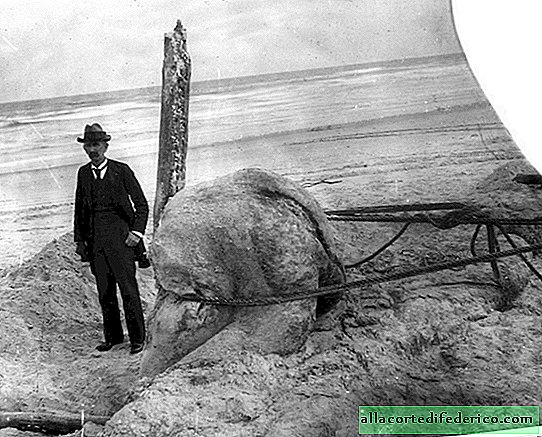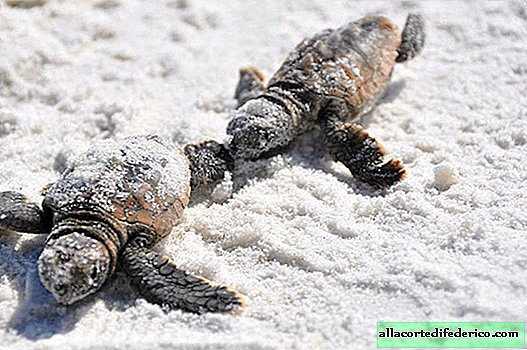When monsters are washed ashore: who are globsters
At the end of November 1896, two American boys from the city of St. Augustine, Florida, rode along the coast when they discovered a huge monster half buried in the sand. The boys immediately informed the only scientist in the city at that time - the doctor DeWitt Webb. The doctor got to the carcass the next day and saw the incredible: it was not a whale at all, but a pale pink mass of decayed flesh.
 Dr. Webb next to a Florida monster
Dr. Webb next to a Florida monsterShe had nothing that could even hint a little at the origin: neither bones, nor eyes, nor any form. Webb figured that the carcass weighs about five tons, and decided that it was a giant octopus. The man took several samples of fabric, and under his leadership the body was transported deep into Florida, where it became a real attraction: hundreds of people came to see and take pictures against the background of a monster from St. Augustine. What happened to the find further is unknown: probably, due to the incredibly strong smell that it exuded, they buried it, and possibly drowned in the sea.
 People lined up to take pictures at the find
People lined up to take pictures at the findA monster from Florida was given the name "giant octopus" (also known as the "giant octopus"). In general, in theory, there were two types of giant octopuses: in fact, a real giant octopus that lives on the bottom of the ocean and usually weighs no more than 30 kilograms, and there is a hypothetical monster that attacks ships. Actually, Webb decided that a monster was thrown onto the beach: how else could one explain the five-ton carcass without the slightest sign of a spine?
Confirmed Webb's theory and the professor of zoology Edison Emery Verill, who at that time was the main authority on mollusks in the scientific world.
Scientists could not calm down with the find for a century. The samples that Webb collected were examined many times. In the 1970s, analysis confirmed that the Florida monster was actually an octopus. Then it was a fantastic discovery: scientists came to the conclusion that the length of the tentacles of this giant reached 30 meters. Another analysis was conducted in the 1980s, and he also confirmed the existence of the monster.
But this theory was still refuted: in 1995, biochemical analysis of samples became possible, they were studied in more detail. As a result, it turned out that the mass is the remains of a whale. In fact, it is fat that is released during rotting of the body.
 Giant octopus attacks a ship
Giant octopus attacks a shipBut finds like the Florida monster were washed ashore all over the world at different times. All of them are called globsters. Usually it is flesh, which has absolutely no defining signs. It was the globsters that strengthened the sailors' belief that at the bottom of the sea there are monsters who attack ships. It was about such monsters that bikes have been around for a thousand years. By the way, some believe in their existence today: cryptozoologists believe that similar remains belong to animal species that are still unknown to science. Moreover, there is even a theory that they do not live in the sea, but in the earth: the remains are often found half immersed in the sand. So this is a great justification for where this terrible creature came from.
 The Stronsey monster The Florida monster was the first officially confirmed globster to be photographed and investigated, but other monster stories are known to science. So, there is the Stronsei monster thrown to the coast of Great Britain in 1808. He was considered none other than a sea serpent.
The Stronsey monster The Florida monster was the first officially confirmed globster to be photographed and investigated, but other monster stories are known to science. So, there is the Stronsei monster thrown to the coast of Great Britain in 1808. He was considered none other than a sea serpent.  Gloster Trunko
Gloster TrunkoAnother famous monster is Gloster Trunko, who was nailed to the beach of South Africa in 1924. Then even eyewitnesses were found. People saw how an unknown creature, similar to a polar bear, fought with killer whales for several hours. A body covered with wool was later washed ashore. However, no one was able to study the find in such detail. But still, in the 2000s, they found out that there wasn’t any wool: in fact, these were fibers of the fabric.
 Gloster on the coast of Chile
Gloster on the coast of ChileAnd in the 21st century, such finds have always generated fantastic theories. So, in 2003, a giant body 12 meters wide and 13 tons in weight was discovered on the coast of Chile. He was not identified immediately, but later they nevertheless found out that it was a carcass of a sperm whale.

















